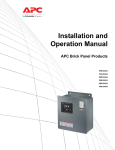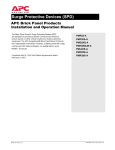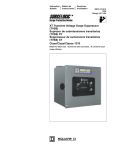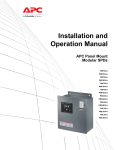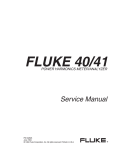Download APC SurgeArrest PM 240/120V 80KA, Non-modular
Transcript
Installation and Operation Manual APC 2X Series Hardwire Products PMP2X-A PMF2X-A PMG2X-A PMH2X-A APC hardwired products are designed to provide specification-grade performance at the service entrance, branch panels, or other critical locations for today’s electrical distribution systems. APC Hardwire Panel Mount Products package multi-phase surge suppression and noise suppression into a compact, economical NEMA 4x enclosure. The units come standard with an audible alarm, dry contacts, and status indicator LEDs. Compliant with UL1449 3rd Edition requirements dated September 29, 2009. Table of Contents Precautions ............................................................................................... 4 Introduction ............................................................................................... 6 Unpacking and Preliminary Inspection ................................................... 7 Storage ....................................................................................................... 7 Identification Nameplate .......................................................................... 7 SPD Location Considerations ................................................................. 7 Environment ................................................................................................ 7 Audible Noise .............................................................................................. 7 Mounting ..................................................................................................... 7 Service Clearance ....................................................................................... 7 Equipment Performance ............................................................................. 7 Electrical .................................................................................................... 8 Voltage Rating ............................................................................................ 8 Wire Leads .................................................................................................. 9 Branch Circuit Overcurrent Protection and Disconnect Means ................... 9 Location of Surge Protective Device (SPD) .............................................. 10 System Grounding .................................................................................. 11 Installation ............................................................................................... 12 Mounting Recommendations .................................................................... 12 Wiring ....................................................................................................... 13 PM2X Series Wiring Diagrams ................................................................. 14 Operation ................................................................................................. 15 LED Status Indicators ............................................................................... 15 Audible Alarm ............................................................................................ 15 Dry Contacts ............................................................................................. 16 Remote Monitor Option ............................................................................. 17 Preventive Maintenance ......................................................................... 18 Customer Support ................................................................................... 20 Installation and Operation Manual 3 Precautions Precautions DANGER HAZARD OF ELECTRIC SHOCK, EXPLOSION, OR ARC FLASH • Apply appropriate personal protective equipment (PPE) and follow safe electrical work practices. See NFPA 70E. • This equipment must only be installed and serviced by qualified electrical personnel. • Turn off all power supplying this equipment before working on or inside equipment. • Always use a properly rated voltage sensing device to confirm power is off. • Replace all devices, doors and covers before turning on power to this equipment. • This equipment must be effectively grounded per all applicable codes. Use an equipment-grounding conductor to connect this equipment to the power system ground. Failure to follow these instructions will result in death or serious injury. CAUTION LOSS OF BRANCH CIRCUIT POWER / LOSS OF SURGE SUPPRESSION • Ensure that the branch circuit breaker or fuse trip characteristic has been coordinated with the overcurrent protection inside the SPD (See Table 1). • Perform periodic inspection of the SPD status indicator lights as part of the preventative maintenance schedule. • Promptly service the SPD when an alarm state exists. • Use dry contacts to signal an alarm state to the central supervisory system for unmanned, inaccessible, or critical installations. • Use multiple SPDs to achieve redundancy for critical applications. Failure to follow these instructions can result in injury or equipment damage. At end-of-life conditions, Surge Protective Devices (SPDs) can lose their ability to suppress power system voltage and attempt to draw excessive current from the line. This SPD is equipped with overcurrent and overtemperature components that will automatically disconnect the surge suppression elements from the mains should the surge suppression elements reach end of life. Tripping of the branch circuit breaker or fuse feeding the SPD can occur. Mitigate the tripping of the branch circuit breaker or fuse feeding the SPD by coordinating the surge suppression elements with the branch circuits. For the purposes of coordination, the SPD is equipped with overcurrent components that will limit the per phase I2t, Iapparent, Ip, and Ith values to those listed in Table 1 when connected to a power system with a shortcircuit current rating not exceeding 200,000 A. 4 Installation and Operation Manual Precautions Table 1: SPD Device Per Phase I2t Iapparent Ip Ith PM2X Series 44 kA2 seconds 8,500 A RMS 20,000 A RMS 110 A CAUTION LOSS OF SURGE SUPPRESSION • During installation into an electrical system, SPDs must not be energized until the electrical system is completely installed, inspected, and tested. All conductors must be connected and functional, including the neutral. The voltage rating of the device and system must always be verified before energizing the surge protective device. • Any factory or on-site testing of power distribution equipment that exceeds the normal operating voltage, such as high potential insulation testing, or any other tests where the suppression components will be subjected to voltages higher than their rated turn-on voltage must be performed with the suppressor disconnected from the power source. The neutral connection at the SPD device must also be disconnected prior to performing high-potential testing and then reconnected upon completion of the test. Failure to follow these instructions can result in injury or equipment damage. NOTE: Type 2 SPDs are designed for use on the load side of the service entrance Overcurrent Protection Device (OCPD) only. NOTE: For troubleshooting, call APC Technical Support at 1-800-800-4272. Proper installation is imperative to maximize the effectiveness and performance of the Surge Protective Device (SPD). The installer should follow the steps outlined in this instruction bulletin to ensure proper installation. Read the entire instruction bulletin before beginning the installation. These instructions are not intended to replace national or local electrical codes. Check all applicable electrical codes to verify compliance. Installation of surge suppressors should only be performed by qualified electrical personnel. Installation and Operation Manual 5 Introduction Introduction Thank you for choosing the APC SurgeArrest® PM_2X Series Hardwire Surge Protection Device. The APC Hardwired Surge Protection Device (SPD) is a high-quality, high-energy surge attenuation system that has been designed to protect sensitive equipment from damaging transient voltage surges. Proper installation is imperative to maximize the surge suppressor’s effectiveness and performance. This manual is to be used as a guide for installing the device. Read and understand all information contained in this manual prior to installation. The outlined procedures are not intended to supersede local or national electrical codes. Check all applicable electrical codes to assure compliance. This device must be installed by qualified electrical personnel. The installer should follow the steps detailed in this manual to ensure proper installation. A copy of the installer’s invoice, detailing the installation of this device, is required in order to take advantage of the unit’s product warranty. The SurgeArrest® PM_2X Series product lines specify a parallel SPD designed for service entrance and downstream panelboard applications. These units provide replaceable hardwire surge protection and are available in 80kA per phase rating. All APC products are extensively tested according to industry standards as set by IEEE C62.41 and C62.45 for Type 2 Applications. Type 2 applications are permanently connected to SPDs intended for installation on the load side of the service equipment overcurrent device; including SPDs at the branch panel. Save this manual! It includes instructions regarding the product warranty and replacement parts. Testing Any factory or on-site testing that exceeds the normal operating voltage, such as high-potential insulation testing or other tests where the suppression components will be subjected to voltages higher than their rated “turn on” voltage, must be run with the suppressor disconnected from the power source. For 4-wire SPD devices, the neutral connection at the SPD must also be disconnected prior to performing high-potential testing and then reconnected upon completion of the test. Failure to disconnect this surge suppression device and its associated suppression components during elevated voltage testing will result in damage to the suppression components and/or other electronic components. 6 Installation and Operation Manual Inspection Unpacking and Preliminary Inspection Inspect the entire shipping container for damage or signs of mishandling before unpacking the device. Remove the packing material and further inspect the device for any obvious shipping damage. If any damage is found and is a result of shipping or handling, immediately file a claim with the shipping company. Storage The device should be stored in a clean, dry environment. Storage temperature is -40 °F to +149 °F (-40 °C to +65 °C). All of the packaging materials should be left intact until the device is ready for installation. Identification Nameplate The identification nameplate is located on the side of the unit. Figure 1: SPD Nameplate Example PM_2X-A _______V 002 100 APC Corporation 1-800-800-4272 www.apc.com 1010 8222-0521A SPD Location Considerations Environment The device is designed to operate in an ambient temperature range of -4 °F to +149 °F (-20 °C to +65 °C) with a relative humidity of 0 to 95% noncondensing. This device has a Type 4X housing. Audible Noise The device background noise is negligible and does not restrict the location of the installation. Mounting The device is designed to be surface mounted. Service Clearance The service clearance should meet all applicable code requirements. Equipment Performance To obtain the maximum system performance, locate the device as close to the circuit being addressed as possible to minimize the interconnecting wiring length. For every foot of wire length, approximately 160 Volts (6 kV / 3 kA, 8/20 microsecond) is added to the suppressed voltage rating. The Voltage Protection Rating (VPR) is located on the device nameplate and is measured six inches from the enclosure sidewall according to UL 1449 Third Edition. Installation and Operation Manual 7 Electrical Electrical DANGER HAZARD OF ELECTRIC SHOCK, EXPLOSION, OR ARC FLASH Confirm the SPD voltage rating on the module or nameplate label is the same as the operating voltage. Failure to follow these instructions will result in death or serious injury. Voltage Rating Prior to mounting the SPD, verify that the device has the same voltage rating as the power distribution system in which it is installed. Compare the nameplate voltage or model number on the SPD with the nameplate of the electrical distribution equipment. The specifier or user of the device should be familiar with the configuration and arrangement of the power distribution system in which the SPD is to be installed. The system configuration of any power distribution system is based strictly on how the secondary windings of the transformer supplying the service entrance main or load are configured. This includes whether or not the transformer windings are referenced to earth via a grounding conductor. The system configuration is not based on how any specific load or equipment is connected to a particular power distribution system. See Table 2 for the service voltage of each SPD. Table 2: 8 APC Hardwired SPD Voltage Ratings / Model Numbers Service Voltage Peak Surge Current Rating Per Phase Model Number 120/240, 1 phase, 3 wire 80 kA PMP2X-A 120/208Y, 127/220Y 3 phase, 3–4 wire 80 kA PMF2X-A 277/480Y, 3 phase, 3–4 wire 80 kA PMG2X-A 220/380Y, 230/400Y, 240/415Y, 3 phase, 3–4 wire 80 kA PMH2X-A Installation and Operation Manual Electrical Wire Leads Twenty-four inch leads are provided. The wire leads are 10 AWG stranded copper wire. See Table 3 for wire color. Table 3: Wire Color Wye and High-Leg Delta Systems Wire Color Phases A, B, and C Black High-Leg Orange Neutral White Ground Green Delta Systems Wire Color Phases A, B, and C Black Branch Circuit Overcurrent Protection and Disconnect Means DANGER HAZARD OF ELECTRIC SHOCK, EXPLOSION, OR ARC FLASH • Use conductors rated for the Overcurrent Protection Device (OCPD) per applicable codes. • Use conductors rated for the application per applicable codes. Failure to follow these instructions will result in death or serious injury. A branch circuit Overcurrent Protection Device (OCPD) either in the form of a circuit breaker or fuse, must be provided for the PM2X device. The branch circuit OCPD should either provide or include a disconnecting means. Since the current drawn by the PM2X device during standby operation is negligible, the PM2X device can be connected to a dedicated, separate branch circuit or connected to a suitable existing branch circuit. When connected to a separate, dedicated branch circuit, the OCPD setting must be selected to protect the conductors feeding the PM2X device per applicable state and local building codes. During surge suppression, current will flow through the PM2X device. The branch circuit OCPD must pass this surge current without tripping for the PM2X device to function properly. For further information concerning coordination of the OCPD with the PM2X device, refer to the Caution statement “Loss of Branch Circuit Power/Loss of Surge Suppression” page 4. Installation and Operation Manual 9 Electrical Location of Surge Protective Device (SPD) Install SPDs on the load side of the main overcurrent protection to comply with NEC® Article 285 for Type 2 SPD. Locate the SPD as close as possible to the circuit being addressed to minimize the wire length and optimize SPD performance. Avoid long wire runs so that the device will perform as intended. To reduce the impedance that the wire displays to surge currents, the phase, neutral, and ground conductors (wye and high-leg delta configurations), or phase conductors (delta configurations), must be routed within the same conduit and tightly bundled or twisted together to optimize device performance. Avoid sharp bends in the conductors. See Figure 2. Figure 2: SPD Wiring for Wye and High-Leg Delta Configurations To load(s) Phase A Phase B Phases Phase C Neutral Neutral Neutral bus Ground Ground Ground bus SPD Panel 10 Installation and Operation Manual Interconnect wiring — Minimize length —Avoid sharp bends Grounding System Grounding CAUTION LOSS OF SURGE PROTECTION • Must be installed on solidly grounded power systems. Do not use on ungrounded systems. • Verify that the service entrance equipment is bonded to ground in accordance with all applicable codes. • Verify that the neutral terminals are grounded to system ground in accordance with all applicable codes. Failure to follow these instructions can result in equipment damage. An equipment grounding conductor must be used on all electrical circuits connected to the SPD. For the best performance, use a single-point ground system where the service entrance grounding electrode system is connected to and bonded to all other available electrodes, building steel, metal water pipes, driven rods, etc. (for reference, see IEEE 142-2007). The ground impedance measurement of the electrical system should be as low as possible, and in compliance with all applicable codes, for sensitive electronics and computer systems. When a metallic raceway is used as an additional grounding conductor, an insulated grounding conductor should be run inside the raceway and sized in accordance with all applicable codes. WARNING INADEQUATE RACEWAY ELECTRICAL CONTINUITY • Ground impedance must be as low as possible and in compliance with all applicable codes for sensitive electronic and computer systems. • Install an insulated grounding conductor inside a metallic raceway when the raceway is used as an additional grounding conductor. Size the conductor in accordance with all applicable codes. • Maintain adequate electrical continuity at all raceway connections. • Do not use isolating bushings to interrupt a metallic raceway run. • Do not use a separate isolated ground for the SPD. • Verify proper equipment connections to the grounding system. • Verify ground grid continuity by inspections and testing as part of a comprehensive electrical maintenance program. Failure to follow these instructions can result in death or serious injury. Installation and Operation Manual 11 Installation Installation DANGER HAZARD OF ELECTRIC SHOCK, EXPLOSION, OR ARC FLASH • Apply appropriate personal protective equipment (PPE) and follow safe electrical work practices. See NFPA 70E. • This equipment must only be installed and serviced by qualified electrical personnel. • Turn off all power supplying this equipment before working on or inside equipment. • Always use a properly rated voltage sensing device to confirm power is off. • Replace all devices, doors and covers before turning on power to this equipment. • This equipment must be effectively grounded per all applicable codes. Use an equipment-grounding conductor to connect this equipment to the power system ground. Failure to follow these instructions will result in death or serious injury. Mounting Recommendations 12 The PM2X SPD should be nipple mounted directly to the equipment being addressed. The measured torque for tightening the lock nut is not to exceed 100 in-lbs. Always use the mounting brackets (provided) as primary support. Installation and Operation Manual Wiring Wiring DANGER HAZARD OF ELECTRIC SHOCK, EXPLOSION, OR ARC FLASH • Apply appropriate personal protective equipment (PPE) and follow safe electrical work practices. See NFPA 70E. • This equipment must only be installed and serviced by qualified electrical personnel. • Turn off all power supplying this equipment before working on or inside equipment. • Always use a properly rated voltage sensing device to confirm power is off. • Replace all devices, doors and covers before turning on power to this equipment. • This equipment must be effectively grounded per all applicable codes. Use an equipment-grounding conductor to connect this equipment to the power system ground. Failure to follow these instructions will result in death or serious injury. DANGER HAZARD OF ELECTRIC SHOCK, EXPLOSION, OR ARC FLASH Confirm the SPD voltage rating on the module or nameplate label is the same as the operating voltage. Failure to follow these instructions will result in death or serious injury. Table 4: Wiring Diagram Location1 Wiring for: Figure and Page Single-phase, 3-wire, grounded installation Figure 4 on page 14 Three-phase, 3- or 4-wire, grounded WYE installation Figure 5 on page 14 1 See “Dry Contacts” on page 16 for dry contact wiring. Follow steps 1 through 7 to make wiring connections. 1. Turn off all power supplying this equipment before working on or inside any enclosure containing this equipment. 2. Confirm surge protective device is rated for your system by comparing voltage measurements to the Line Voltage (L-L, L-N) on the product label. 3. Identify proper location for surge protective device. Locate as close as possible to the panel being addressed so the wires are as short as possible. Mount unit securely. See Figure 3 for mounting instructions. NOTE: The surge protective device must be installed in an accessible location (not within walls). 4. Install in accordance with national and local electrical codes and match branch circuit Overcurrent Protection Device (OCPD) to the wire size. 5. Twist conductor 1/2 turn or more for every 12 inches of length. 6. Do not loop or coil wires. Be sure to maintain adequate wire bending space per NEC® 2008 Article 408. 7. Unless installing a delta product, use on grounded systems only. NOTE: On a high-leg delta installation, the high-leg of the power system must be connected to the orange wire of the SPD. NOTE: Always install the SPD on the LOAD side of the main disconnect. Installation and Operation Manual 13 Wiring PM2X Series Wiring Diagrams Figure 3: Mounting Unit Figure 4: Single-Phase, 3-Wire, Grounded Installation Figure 5: Three-Phase, 3- or 4-Wire, Grounded Wye Installation Lock Nut 0.75 in. [19 mm] knockout (trade size) Actual hole size 1.0 in. [25 mm] NOTE: The neutral conductor is not present on 3-wire, grounded neutral power systems. For proper operation of diagnostics, the neutral (white) conductor of the SPD must be connected to ground. 14 Installation and Operation Manual Operation Operation DANGER HAZARD OF ELECTRIC SHOCK, EXPLOSION, OR ARC FLASH • Apply appropriate personal protective equipment (PPE) and follow safe electrical work practices. See NFPA 70E. • This equipment must only be installed and serviced by qualified electrical personnel. • Turn off all power supplying this equipment before working on or inside equipment. • Always use a properly rated voltage sensing device to confirm power is off. • Replace all devices, doors and covers before turning on power to this equipment. • This equipment must be effectively grounded per all applicable codes. Use an equipment-grounding conductor to connect this equipment to the power system ground. Failure to follow these instructions will result in death or serious injury. LED Status Indicators LEDs are located on the front of the HWA SPD device. They operate as follows: • Verify that all phase voltages are present. If none of the LEDs are illuminated, the device may not be installed correctly. Check the power supply and service voltage. Upon energizing the SPD, check the LED status. • • If all of the LEDs are illuminated, surge suppression is operating. • If an inoperative condition occurs the device must be replaced by qualified electrical personnel. If one or more LEDs are not illuminated, there is a loss of surge suppression on that phase. Figure 6: Diagnostic Operation LED ON = OK 8222-0012-07 LED OFF = Loss of surge suppression on that phase and/or Audible Alarm ON = Loss of surge suppression Audible Alarm The audible alarm does not have a silence switch. Silence the alarm by removing power from the SPD (open the circuit breaker that it is connected to). The alarm indicates that the device needs replacement by qualified electrical personnel. Installation and Operation Manual 15 Operation Dry Contacts The PM2X series SPD device is provided with dry contacts. The connection for the dry contacts is provided by 24-inch wire leads. The wire leads are 22 AWG stranded copper wire. See Table 5 for wire color and contact state. The unpowered state shall be closed between the red wire (common) and the yellow wire (normally closed). This is also the alarm condition. The opposite state, closed between the red wire (common) and the blue wire (normally open), indicates that power is on to the unit and that no alarm condition exists (See Table 5). These dry contact leads can be used for remote indication of the SPD operating status to a computer interface board or emergency management system. Also, these dry contact leads are designed to work with the SPD remote monitor option described below. The dry contacts are designed for a maximum voltage of 24 Vdc / 24 Vac and a maximum current of 2 A. Higher energy applications may require additional relay implementation outside the SPD. Damage to the SPD’s relay caused by use with energy levels in excess of those discussed in this instruction bulletin are not covered by warranty. For application questions, call APC Technical Support at 1-800-800-4272. Table 5: Wire Color Normal Contact State1 Blue Closed Red Common Yellow Open 1 16 Dry Contact Configuration Normal state shown is with AC power on the SPD. Installation and Operation Manual Operation Remote Monitor Option The option has two LEDs, one red and one green, and an audible alarm with an enable/disable switch. Normal status is a lit green LED, and no audible alarm. To test the integrity of the remote monitor, press the push-to-test switch. The green LED will turn off, the red LED will turn on, and the alarm will sound, if the alarm is enabled. Releasing the switch will complete the test; the red LED will turn off, the green LED will turn on and the alarm will shut off. If protection on any phase is lost, the green LED will turn off, the red LED will illuminate and an alarm will sound. The audible alarm can be silenced by pushing the alarm enable/disable/test switch. The alarm will silence and the green alarm LED will not be lit. The red LED will continue to be illuminated until the inoperative condition has been cleared. The remote monitor includes a 120 Vac to 12 Vdc adapter with a six-foot power cord. Connections are made to the PM2X SPD diagnostic panel with the 24-inch dry contact leads (provided). To extend the remote monitor further (up to 1,000 ft. [305 m]), use an additional length of solid or stranded 30 to 14 AWG wire (not provided). Figure 7: Remote Monitor Option 0.230 [5.86] 4.400 [111.76] 3.950 [100.3] 3.500 [88.9] 0.460 [5.86] 1.25 2.500 [31.8] [63.5] 2x Ø 0.187 [4.75] = OK = Fault / Falla / Défaut Monitor Remoto / Moniteur À Distance Bouton pousser pour vérifier 120 V power cord 0.130 [3.3] Dry Contacts 1.125 [28.58] Installation and Operation Manual 17 Maintenance Preventive Maintenance DANGER HAZARD OF ELECTRIC SHOCK, EXPLOSION, OR ARC FLASH • Apply appropriate personal protective equipment (PPE) and follow safe electrical work practices. See NFPA 70E. • This equipment must only be installed and serviced by qualified electrical personnel. • Turn off all power supplying this equipment before working on or inside equipment. • Always use a properly rated voltage sensing device to confirm power is off. • Replace all devices, doors and covers before turning on power to this equipment. • This equipment must be effectively grounded per all applicable codes. Use an equipment-grounding conductor to connect this equipment to the power system ground. Failure to follow these instructions will result in death or serious injury. Inspect the SPD periodically to maintain reliable system performance and continued transient voltage surge suppression. Periodically check the state of the display LED status indicators. 18 Installation and Operation Manual Installation and Operation Manual 19 APC Worldwide Customer Support Customer support for this or other APC products is available at no charge in the following ways: • Visit the APC website to access documents in the APC Knowledge Base and to submit customer support requests. — www.apc.com (Corporate Headquarters) Connect to localized APC Web sites for specific countries, each of which provides customer support information. — www.apc.com/support Global support searching APC Knowledge Base and using e-support. • Contact the APC Customer Support Center by telephone or e-mail. — Local, country-specific centers: go to www.apc.com/support/contact for contact information. For information on how to obtain local customer support, contact the APC representative or other distributors from whome you purchased your APC product. © 2010 Schneider Electric USA, Inc. APC, the APC logo, and APC SurgeArrest® are owned by Schneider Electric Industries S.A.S., American Power Conversion Corporation, or their affiliated companies. All trademarks are property of their respective owners. 990-3425A (8251-0142C) 10/2010





















